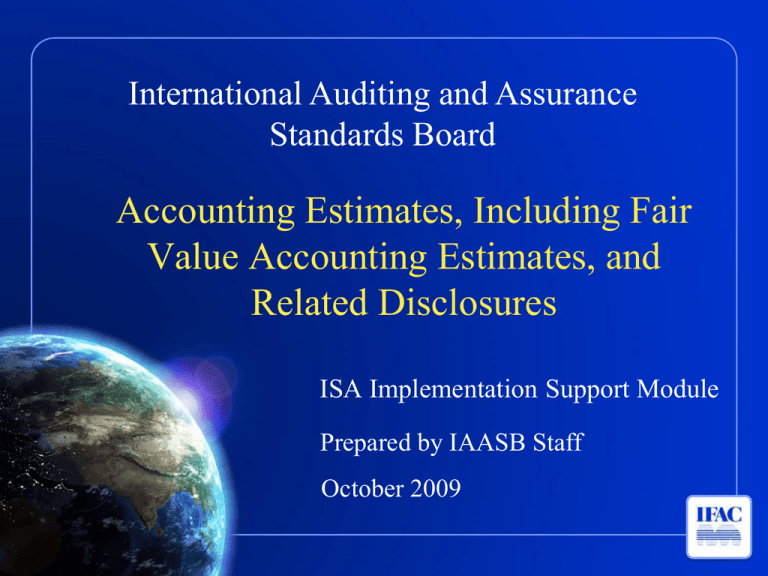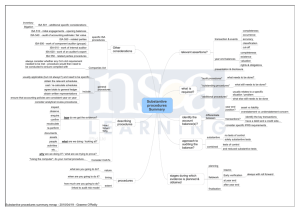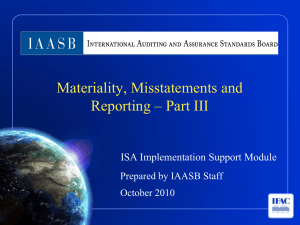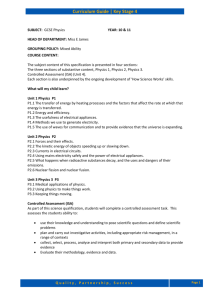
International Auditing and Assurance
Standards Board
Accounting Estimates, Including Fair
Value Accounting Estimates, and
Related Disclosures
ISA Implementation Support Module
Prepared by IAASB Staff
October 2009
Overview
• Introduction
• Risk-Based Approach
• Estimation Uncertainty
• Responses to Assessed Risks
• Indicators of Possible Management Bias
• Disclosures Related to Accounting Estimates
• Additional Aspects of ISA 540
• SME Considerations
2
Introduction
IAASB’s Objectives in Revising ISA 540
• To increase the rigor and skepticism to be
applied in auditing accounting estimates
• To provide enhanced guidance on estimation
uncertainty and management bias
• To conform with the risk-based approach
reflected in ISA 315 and ISA 330
3
Introduction
Auditor’s Objective
• To obtain sufficient appropriate audit evidence
about whether
– accounting estimates, including fair value
accounting estimates, in the financial
statements, whether recognized or disclosed,
are reasonable; and
– related disclosures are adequate,
in the context of the applicable financial
reporting framework
4
Introduction
Application to Both Accounting Estimates
and Fair Value Accounting Estimates
• Principles in auditing fair values and more
traditional accounting estimates are the same
• Application material in ISA 540 explains how
particular requirements are applied in the context of
both accounting estimates and fair values
• More guidance has been added related to fair value
auditing considerations, including the use of models
• Extant ISA 545 to be withdrawn
5
Risk-Based Approach
Risk Assessment Procedures
• Understanding of how management makes the
accounting estimates, and of the underlying data
– The method, including the applicable model, used and
changes in the method from the prior period
– Relevant controls
– Whether an expert has been used
– The underlying assumptions
– Whether and, if so, how management has assessed the
effects of estimation uncertainty
6
Risk-Based Approach
Risk-Based Approach
• ISA 540 expands on how ISAs 315, 330, and
others are to be applied to accounting estimates
– Obtaining an understanding of the entity and its
environment, through risk assessment procedures
– Based on that understanding, identifying and
assessing the risks of material misstatement
– Obtaining sufficient appropriate audit evidence
regarding the assessed risks, through designing and
implementing appropriate responses to those risks
7
Risk-Based Approach
Risk Assessment Procedures
• Understanding of the requirements of the
applicable financial reporting framework
relevant to accounting estimates, including
related disclosures
• Understanding of how management identifies
the need for accounting estimates to be
recognized or disclosed
– Includes making inquiries about changes in
circumstances that may give rise to new accounting
estimates or the need to revise existing ones
8
Risk-Based Approach
Risk Assessment Procedures
• Review the outcome of accounting estimates
included in the prior period financial statements
or, as applicable, their subsequent re-estimation
in the current period
– Nature and extent of review takes account of the
nature of the estimate and whether information to be
obtained is likely relevant to identifying and assessing
risks
– Not intended to revisit prior judgments
9
Risk-Based Approach
Identifying and Assessing Risks of Material
Misstatement
• In identifying and assessing risks
– Evaluate the degree of estimation uncertainty
associated with an accounting estimate
– Determine whether, in the auditor’s judgment, any of
those accounting estimates that have been identified
as having high estimation uncertainty gives rise to
significant risks
10
Estimation Uncertainty
Nature of Estimation Uncertainty
• The susceptibility of an accounting
estimate to an inherent lack of precision in
its measurement
• The degree of estimation uncertainty
affects the risk that the financial statements
are materially misstated and whether an
estimate is particularly susceptible to
management bias
11
Estimation Uncertainty
Evaluation of Estimation Uncertainty
• Evaluating the degree of estimation
uncertainty associated with an accounting
estimate includes consideration of, for
example,
– Level of judgment involved
– Sensitivity to changes in assumptions
– Extent to which the estimate is based on
observable or unobservable inputs
12
Responses to Assessed Risks
Responding to the Assessed Risks
• Based on the assessed risks, determine
– Whether management has appropriately applied
the requirements of the applicable financial
reporting framework
– Whether the methods for making accounting
estimates are appropriate and applied consistently
If there have been changes in the method, are they
appropriate?
13
Responses to Assessed Risks
Responding to the Assessed Risks
• One or more of the following, taking account
of nature of the accounting estimate
– Use of evidence from events occurring up to the
date of the auditor’s report
– Testing of how management made the
accounting estimate and underlying data
Includes evaluation of measurement method and
reasonableness of assumptions
14
Responses to Assessed Risks
Responding to the Assessed Risks
• Testing the operating effectiveness of controls,
together with appropriate substantive
procedures
• Developing a point estimate or range to evaluate
management’s point estimate
– Remains necessary to understand management’s
assumptions and methods
– Range needs to be narrowed based on audit evidence
until all outcomes within the range are considered
reasonable
15
Responses to Assessed Risks
Further Substantive Procedures to Respond
to Significant Risks
• Evaluate how management has considered
alternative assumptions or outcomes and why
they have been rejected, or how management
has otherwise addressed estimation uncertainty
• Evaluate whether the significant assumptions
used are reasonable
• Where relevant, evaluate management’s intent
and ability
16
Responses to Assessed Risks
Further Substantive Procedures to Respond
to Significant Risks
• Where necessary, develop a range to evaluate
reasonableness of the accounting estimate
– Done when, in the auditor’s judgment,
management has not adequately addressed the
effects of estimation uncertainty
• Obtain sufficient appropriate audit evidence
regarding recognition and measurement
decisions
17
Indicators of Possible Management Bias
Identifying Indicators
• Review the judgments and decisions made by
management in making accounting estimates to
identify whether there are indicators of possible
management bias
– Susceptibility of an estimate to management bias
increases with subjectivity involved
– Indicators may affect auditor’s conclusion of
whether risk assessment or responses remain
appropriate, but do not themselves constitute
misstatements for purposes of concluding on
reasonableness of individual estimates
18
Indicators of Possible Management Bias
Examples
• Changes in an accounting estimate or method where
management has made a subjective assessment that
there has been a change in circumstances
• Use of an entity’s own assumptions for fair value when
they are inconsistent with observable marketplace
assumptions
• Selection or construction of significant assumptions
that yield a point estimate favorable to management’s
objectives
• Selection of a point estimate that may indicate a pattern
19
of optimism or pessimism
Disclosures Related to Accounting Estimates
Disclosures
• Obtain sufficient appropriate audit evidence
about whether disclosures related to accounting
estimates are in accordance with the applicable
financial reporting framework
• For estimates giving rise to significant risks,
also evaluate the adequacy of the disclosure of
estimation uncertainty in the context of the
applicable financial reporting framework
20
Additional Aspects of ISA 540
Using Specialized Skills or Knowledge
• In response to assessed risks, consider whether
specialized skills or knowledge in relation to
aspects of the accounting estimate are needed to
obtain sufficient appropriate audit evidence
– Individuals become part of the engagement team if
the matters are accounting- and auditing-related
– Those with experience in a field other than
accounting or auditing are considered auditor’s
experts and ISA 620 applies
21
Additional Aspects of ISA 540
Written Representations
• Obtain written representations regarding the
reasonableness of significant assumptions used in
making accounting estimates
– Representations alone do not constitute sufficient
appropriate audit evidence
• Guidance provided regarding additional
representations the auditor may consider depending
on nature, materiality, and extent of estimation
uncertainty
22
Additional Aspects of ISA 540
Documentation
• Document
– The basis for the auditor’s conclusions about
the reasonableness of accounting estimates and
their disclosure that give rise to significant
risks
– Indicators of possible management bias, if any
23
SME Considerations
Applicability of the ISA to SME Audits
• Obtaining an understanding of how management (or
owner-manager) identifies the need for accounting
estimates is often relatively straightforward
• The ISA allows for different approaches for
responding to assessed risks depending on the nature
of the accounting estimate
• In many cases (other than for fair value estimates),
review of events occurring up to the date of the
auditor’s report may be an effective and efficient
approach
24
Note
This set of support slides does not amend or override
the ISAs, the texts of which alone are authoritative.
Reading the slides is not a substitute for reading the
ISAs. The slides are not meant to be exhaustive and
reference to the ISAs themselves should always be
made. In conducting an audit in accordance with
ISAs, the auditor is required to comply with all the
ISAs that are relevant to the engagement.
25
International Federation
of Accountants
Copyright © October 2009 by the International Federation of Accountants
(IFAC). All rights reserved. Permission is granted to make copies of this work
provided that such copies are for use in academic classrooms or for personal use
and are not sold or disseminated and provided that each copy bears the
following credit line: “Copyright © October 2009 by the International
Federation of Accountants (IFAC). All rights reserved. Used with permission of
IFAC. Contact permissions@ifac.org for permission to reproduce, store, or
transmit this work.” Otherwise, written permission from IFAC is required to
reproduce, store, or transmit, or to make other similar uses of, this work, except
as permitted by law. Contact permissions@ifac.org.
ISBN: 978-1-60815-040-3
www.ifac.org








